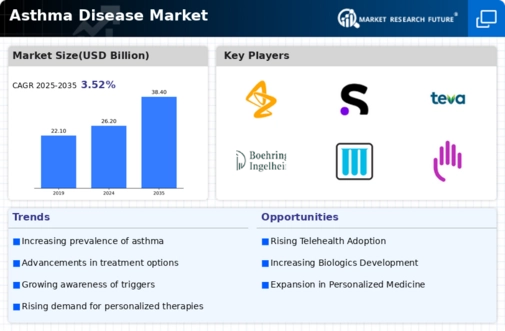Rising Awareness and Education
Rising awareness and education about asthma are crucial drivers for the Asthma Disease Market. Public health campaigns and educational initiatives have significantly increased knowledge regarding asthma management and prevention. This heightened awareness encourages individuals to seek medical advice and adhere to prescribed treatment regimens, ultimately leading to better health outcomes. Furthermore, healthcare professionals are increasingly trained to recognize and manage asthma effectively, which contributes to improved patient care. The emphasis on patient education has also led to the development of digital health tools that assist in monitoring and managing asthma symptoms. As awareness continues to grow, the demand for asthma-related products and services is expected to rise, positively impacting the Asthma Disease Market.
Increasing Prevalence of Asthma
The rising prevalence of asthma is a critical driver for the Asthma Disease Market. According to recent estimates, approximately 300 million individuals are affected by asthma worldwide, with numbers expected to rise due to urbanization and environmental changes. This increase in prevalence necessitates a greater demand for effective treatment options and management strategies. The growing awareness of asthma as a chronic condition has led to enhanced healthcare initiatives aimed at improving patient outcomes. Consequently, pharmaceutical companies are investing in research and development to create innovative therapies, thereby expanding their market presence. The increasing burden of asthma on healthcare systems further emphasizes the need for effective solutions, making this a pivotal factor in the growth of the Asthma Disease Market.
Advancements in Treatment Options
Advancements in treatment options represent a significant driver for the Asthma Disease Market. The introduction of biologics and targeted therapies has transformed asthma management, offering new hope for patients with severe forms of the disease. These innovative treatments, which include monoclonal antibodies, have shown promising results in clinical trials, leading to improved patient outcomes and reduced healthcare costs. The market for biologics is projected to grow substantially, with estimates suggesting it could reach several billion dollars in the coming years. As healthcare providers increasingly adopt these advanced therapies, the Asthma Disease Market is likely to experience robust growth, driven by the demand for more effective and personalized treatment solutions.
Technological Innovations in Monitoring
Technological innovations in monitoring asthma symptoms are emerging as a key driver for the Asthma Disease Market. The integration of digital health solutions, such as mobile applications and wearable devices, allows patients to track their symptoms and medication usage in real-time. These technologies facilitate better communication between patients and healthcare providers, leading to more personalized care. The market for digital health solutions is expanding rapidly, with projections indicating significant growth in the coming years. As patients become more engaged in their asthma management through these tools, the demand for related products and services is likely to increase. This trend underscores the importance of technology in enhancing asthma care and represents a substantial opportunity for growth within the Asthma Disease Market.
Regulatory Support and Policy Initiatives
Regulatory support and policy initiatives play a vital role in shaping the Asthma Disease Market. Governments and health organizations are increasingly recognizing asthma as a public health priority, leading to the implementation of policies aimed at improving asthma care. These initiatives often include funding for research, subsidies for asthma medications, and the establishment of guidelines for asthma management. Such supportive measures not only enhance access to treatment but also encourage pharmaceutical companies to invest in the development of new therapies. The alignment of regulatory frameworks with the needs of patients and healthcare providers is likely to foster innovation and growth within the Asthma Disease Market, as stakeholders work collaboratively to address the challenges posed by asthma.


















Leave a Comment